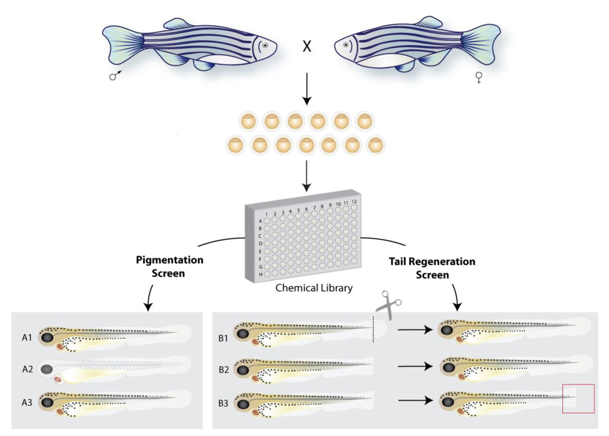Zebrafish ( Danio rerio ) possesses the physiology complexity of mammalian animals and is one of the most common vertebrate model organisms. Creative Biostructure establishes the MagHelix™ Zebrafish Screening Platform for medical research. Zebrafish is an excellent choice to model various diseases and screen novel drugs for medical and therapeutic research. Zebrafish larvae have been used increasingly within the last decade to assess the effects of chemical compounds.
 Figure 1. Phenotype-based chemical screening in zebrafish.
Figure 1. Phenotype-based chemical screening in zebrafish.
Using the zebrafish as animal model is the feature of this platform. The main research fields of the platform are: 1) Generating multiple transgenic zebrafish models for human disease; 2) Research and development of drug candidates based on screening results.
There are various assays based on MagHelix™ Zebrafish Screening Platform shown in the following table. Take the cardiovascular toxicity test as an example, which is a key limiting factor in drug discovery. One of the features that the zebrafish heart can be dissected rapidly and maintained ex vivo for several days makes zebrafish an excellent model for assessment of cardiovascular toxicity.
| Angiogenesis assay | |
| mRNA expression marker (Each gene) | |
| Toxicity tests | General toxicity on survival rates of zebrafish embryo or larvae |
| Cardiotoxicity test in zebrafish | |
| Toxicity test to development of motor neuron or dopaminergic neuron in zebrafish | |
| Human Endothelial Cell (HUVEC) model | Proliferation assay |
| Adhesion assay | |
| Migration assay | |
| Tube formation assay | |
| Tg (Fli-1: EGFP) and Tg (Fli-1: nEGFP) transgenic zebrafish model | Normal angiogenesis assay in larvae |
| Tg (Fli-1: EGFP) zebrafish fin regeneration model | |
| Regenerative angiogenesis assay in adult zebrafish | |
| Neurological disorder model | Protective effect against H 2 O 2 induced PC12 cell damage |
| Protective effect against H 2 O 2 induced SH-SY5Y cell damage | |
| Protective effect against L-glutaric acid (LGA) induced neuron cell death in zebrafish | |
| Protective effect against MPTP or 6-OHDA induced dopaminergic neuron cell death in zebrafish (Parkinson’s disease) | |
| Protective effect against MPTP or 6-OHDA induced deficit of locomotor behavior in zebrafish (Parkinson’s disease) | |
| Protective effect against chemical-induced epilepsy in zebrafish | |
| Cardiovascular disease model | Protective effect against chemotherapy drug-induced cardiac damage in zebrafish |
| Protective effect against chemical-induced cerebral hemorrhage in zebrafish | |
| Skeletal disease model | Bone anabolic effect in zebrafish |
| Immunological model | Immunosuppressive effect on T-cell in zebrafish |
Creative Biostructure welcomes global academic institutions, biotechnology, and pharmaceutical industries to utilize our MagHelix™ Zebrafish Screening Platform to evaluate the activity and toxicity of compounds for drug development.
References
Related Sections

Easy access to products and services you need from our library via powerful searching tools